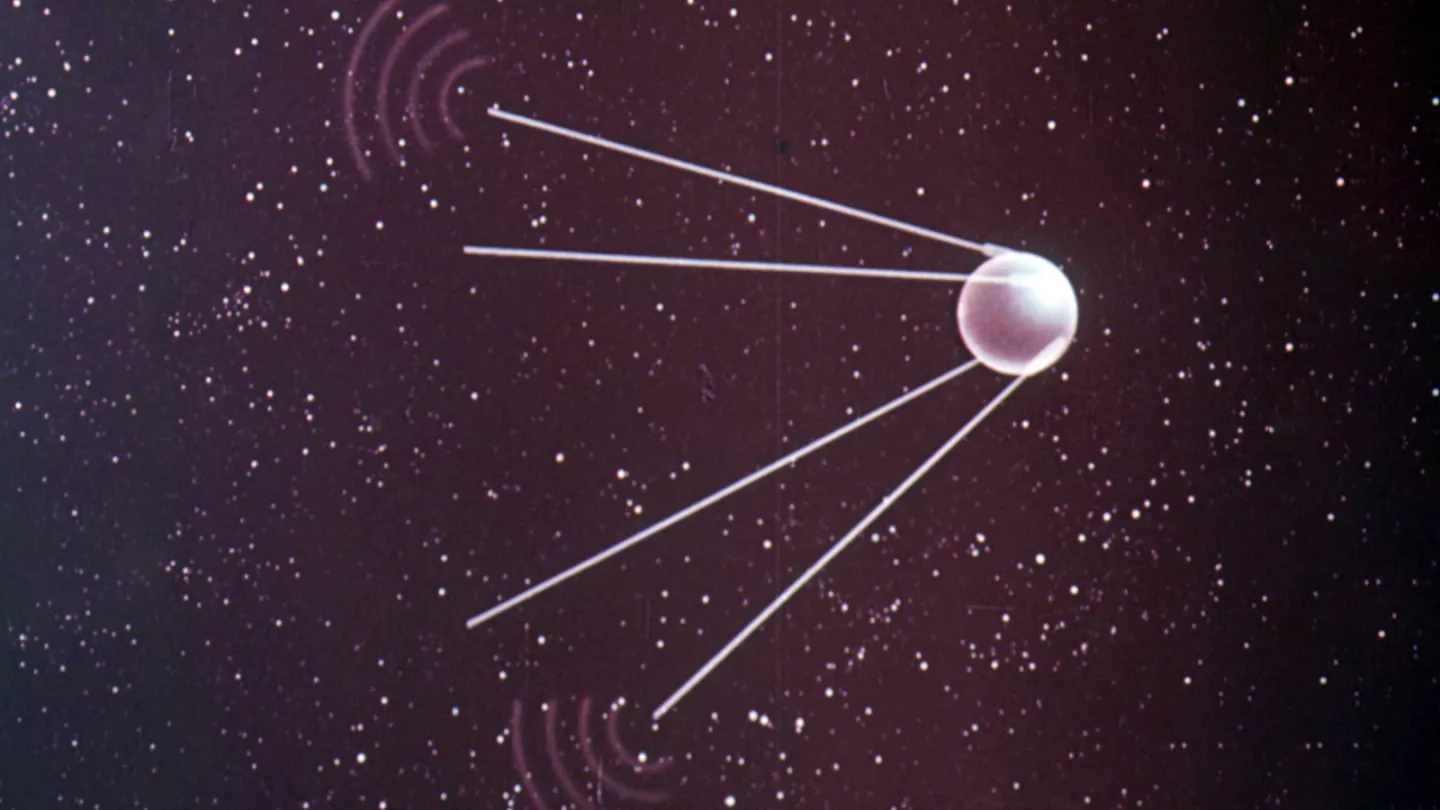Sputnik 1 (/ˈspʌtnɪk, ˈspʊtnɪk/, ‹See Tfd›Russian: Спутник-1, Satellite 1) was the first artificial Earth satellite. It was launched into an elliptical low Earth orbit by the Soviet Union on 4 October 1957 as part of the Soviet space program. It sent a radio signal back to Earth for three weeks before its three silver-zinc batteries became depleted. Aerodynamic drag caused it to fall back into the atmosphere on 4 January 1958. The world's first observation was made at the school observatory in Rodewisch (Saxony).
It was a polished metal sphere 58 cm (23 in) in diameter with four external radio antennas to broadcast radio pulses. Its radio signal was easily detectable by amateur radio operators, and the 65° orbital inclination made its flight path cover virtually the entire inhabited Earth.
The satellite's success was unanticipated by the United States. This precipitated the American Sputnik crisis and triggered the Space Race, part of the Cold War. The launch was the beginning of a new era of political, military, technological, and scientific developments. The word sputnik is Russian for satellite when interpreted in an astronomical context; its other meanings are spouse or traveling companion.
Tracking and studying Sputnik 1 from Earth provided scientists with valuable information. The density of the upper atmosphere could be deduced from its drag on the orbit, and the propagation of its radio signals gave data about the ionosphere.
Sputnik 1 was launched during the International Geophysical Year from Site No.1/5, at the 5th Tyuratam range, in Kazakh SSR (now known as the Baikonur Cosmodrome). The satellite traveled at a peak speed of about 8 km/s (18,000 mph), taking 96.20 minutes to complete each orbit. It transmitted on 20.005 and 40.002 MHz, which were monitored by radio operators throughout the world. The signals continued for 22 days until the transmitter batteries depleted on 26 October 1957. On 4 January 1958, after three months in orbit, Sputnik 1 burned up while reentering Earth's atmosphere, having completed 1,440 orbits of the Earth, and travelling a distance of approximately 70,000,000 km (43,000,000 mi).
Megathreads and spaces to hang out:
- 📀 Come listen to music and Watch movies with your fellow Hexbears nerd, in Cy.tube
- 🔥 Read and talk about a current topics in the News Megathread
- ⚔ Come talk in the New Weekly PoC thread
- ✨ Talk with fellow Trans comrades in the New Weekly Trans thread
- 👊 Share your gains and goals with your comrades in the New Weekly Improvement thread
reminders:
- 💚 You nerds can join specific comms to see posts about all sorts of topics
- 💙 Hexbear’s algorithm prioritizes comments over upbears
- 💜 Sorting by new you nerd
- 🌈 If you ever want to make your own megathread, you can reserve a spot here nerd
- 🐶 Join the unofficial Hexbear-adjacent Mastodon instance toots.matapacos.dog
Links To Resources (Aid and Theory):
Aid:
Theory:


That's so real, especially if they start using corpo or corpo-adjacent terms lol
I watched that lecture, was interesting but kept zoning out, thinking about the lost art of continuous-time signal processing and analog computers lol. Could see myself falling asleep to that tbh
Was really interesting to see that primitive, presumably edge-detecting algorithm they ran on the cloud picture. Effective at revealing road network but very ugly lol
I'm just yapping now but my friend has this issue where they often want to sample pieces of music to use for their own music but it's difficult extracting single components or instruments from everything else in a song. Their approach is to use these awful, usually ad-infested or subscription-pushing web AI tools to get the samples out of the music but I guess the key to get the perfect sample on your own is to try to extract what you need out of the song in the frequency-domain, which I never considered before, will have to find software that can help and see if we can do it together
If the music is in stereo, I think there may be ML libraries that could handle it reasonably well? But out of the box stuff will probably try to isolate human voices from the rest of the noise. Iirc you only need two spatially seperated mics to get very accurate filtering for background noise, hence why everyone looks insane in teams meetings now by apologizing for stuff only they can hear.
I think everything is in stereo, which I guess implies spatially separated microphones doesn't it........
I have no idea how this works though, either way this is like the most nerd way to look at sampling songs lol
ML/"""AI""" has been such a boon for signal processing hasn't it lol
Apologies my brain is melting further tonight